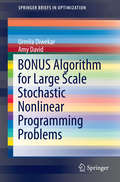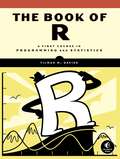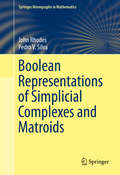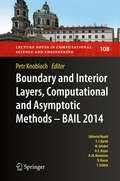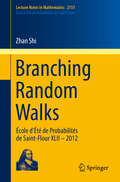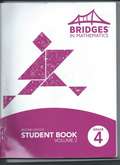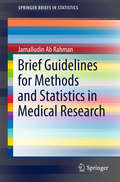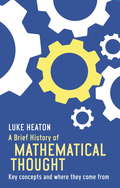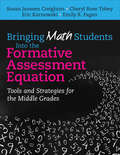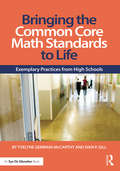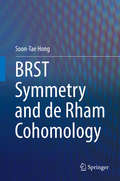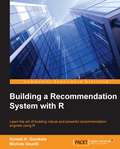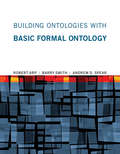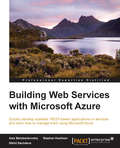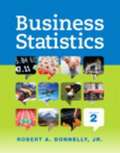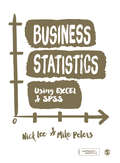- Table View
- List View
The Bloch-Kato Conjecture for the Riemann Zeta Function
by John Coates A. Raghuram Anupam Saikia R. SujathaThere are still many arithmetic mysteries surrounding the values of the Riemann zeta function at the odd positive integers greater than one. For example, the matter of their irrationality, let alone transcendence, remains largely unknown. However, by extending ideas of Garland, Borel proved that these values are related to the higher K-theory of the ring of integers. Shortly afterwards, Bloch and Kato proposed a Tamagawa number-type conjecture for these values, and showed that it would follow from a result in motivic cohomology which was unknown at the time. This vital result from motivic cohomology was subsequently proven by Huber, Kings, and Wildeshaus. Bringing together key results from K-theory, motivic cohomology, and Iwasawa theory, this book is the first to give a complete proof, accessible to graduate students, of the Bloch-Kato conjecture for odd positive integers. It includes a new account of the results from motivic cohomology by Huber and Kings.
BONUS Algorithm for Large Scale Stochastic Nonlinear Programming Problems (SpringerBriefs in Optimization)
by Urmila Diwekar Amy DavidThis book presents the details of the BONUS algorithm and its real world applications in areas like sensor placement in large scale drinking water networks, sensor placement in advanced power systems, water management in power systems, and capacity expansion of energy systems. A generalized method for stochastic nonlinear programming based on a sampling based approach for uncertainty analysis and statistical reweighting to obtain probability information is demonstrated in this book. Stochastic optimization problems are difficult to solve since they involve dealing with optimization and uncertainty loops. There are two fundamental approaches used to solve such problems. The first being the decomposition techniques and the second method identifies problem specific structures and transforms the problem into a deterministic nonlinear programming problem. These techniques have significant limitations on either the objective function type or the underlying distributions for the uncertain variables. Moreover, these methods assume that there are a small number of scenarios to be evaluated for calculation of the probabilistic objective function and constraints. This book begins to tackle these issues by describing a generalized method for stochastic nonlinear programming problems. This title is best suited for practitioners, researchers and students in engineering, operations research, and management science who desire a complete understanding of the BONUS algorithm and its applications to the real world.
The Book of R: A First Course in Programming and Statistics
by Tilman M. DaviesThe Book of R is a comprehensive, beginner-friendly guide to R, the world’s most popular programming language for statistical analysis. Even if you have no programming experience and little more than a grounding in the basics of mathematics, you’ll find everything you need to begin using R effectively for statistical analysis.You’ll start with the basics, like how to handle data and write simple programs, before moving on to more advanced topics, like producing statistical summaries of your data and performing statistical tests and modeling. You’ll even learn how to create impressive data visualizations with R’s basic graphics tools and contributed packages, like ggplot2 and ggvis, as well as interactive 3D visualizations using the rgl package.Dozens of hands-on exercises (with downloadable solutions) take you from theory to practice, as you learn:–The fundamentals of programming in R, including how to write data frames, create functions, and use variables, statements, and loops–Statistical concepts like exploratory data analysis, probabilities, hypothesis tests, and regression modeling, and how to execute them in R–How to access R’s thousands of functions, libraries, and data sets–How to draw valid and useful conclusions from your data–How to create publication-quality graphics of your resultsCombining detailed explanations with real-world examples and exercises, this book will provide you with a solid understanding of both statistics and the depth of R’s functionality. Make The Book of R your doorway into the growing world of data analysis.
Boolean Representations of Simplicial Complexes and Matroids (Springer Monographs in Mathematics)
by John Rhodes Pedro V. SilvaThis self-contained monograph explores a new theory centered around boolean representations of simplicial complexes leading to a new class of complexes featuring matroids as central to the theory. The book illustrates these new tools to study the classical theory of matroids as well as their important geometric connections. Moreover, many geometric and topological features of the theory of matroids find their counterparts in this extended context. Graduate students and researchers working in the areas of combinatorics, geometry, topology, algebra and lattice theory will find this monograph appealing due to the wide range of new problems raised by the theory. Combinatorialists will find this extension of the theory of matroids useful as it opens new lines of research within and beyond matroids. The geometric features and geometric/topological applications will appeal to geometers. Topologists who desire to perform algebraic topology computations will appreciate the algorithmic potential of boolean representable complexes.
Boundary and Interior Layers, Computational and Asymptotic Methods - BAIL 2014 (Lecture Notes in Computational Science and Engineering #108)
by Petr KnoblochThis volume offers contributions reflecting a selection of the lectures presented at the international conference BAIL 2014, which was held from 15th to 19th September 2014 at the Charles University in Prague, Czech Republic. These are devoted to the theoretical and/or numerical analysis of problems involving boundary and interior layers and methods for solving these problems numerically. The authors are both mathematicians (pure and applied) and engineers, and bring together a large number of interesting ideas. The wide variety of topics treated in the contributions provides an excellent overview of current research into the theory and numerical solution of problems involving boundary and interior layers.
Branching Random Walks: École d'Été de Probabilités de Saint-Flour XLII – 2012 (Lecture Notes in Mathematics #2151)
by Zhan ShiProviding an elementary introduction to branching random walks, the main focus of these lecture notes is on the asymptotic properties of one-dimensional discrete-time supercritical branching random walks, and in particular, on extreme positions in each generation, as well as the evolution of these positions over time. Starting with the simple case of Galton-Watson trees, the text primarily concentrates on exploiting, in various contexts, the spinal structure of branching random walks. The notes end with some applications to biased random walks on trees.
Bridges in Mathematics: Student Book, Volume 2
by The Math Learning CenterBridges in Mathematics is a standards-based K-5 curriculum that provides a unique blend of concept development and skills practice in the context of problem solving. It incorporates the Number Corner, a collection of daily skill-building activities for students.
Bridges in Mathematics, Grade 4: Student Book, Volumes 1 and 2
by The Math Learning CenterNIMAC-sourced textbook
Bridges in Mathematics, Grade 4, Home Connections
by The Math Learning CenterNIMAC-sourced textbook
Bridges in Mathematics, Home Connections, Grade 2
by The Math Learning CenterNIMAC-sourced textbook
Bridges in Mathematics, Home Connections, Grade 3
by The Math Learning CenterNIMAC-sourced textbook
Bridges in Mathematics, Home Connections, Grade 5
by The Math Learning CenterNIMAC-sourced textbook
Brief Guidelines for Methods and Statistics in Medical Research (SpringerBriefs in Statistics #0)
by Jamalludin Ab RahmanThis book serves as a practical guide to methods and statistics in medical research. It includes step-by-step instructions on using SPSS software for statistical analysis, as well as relevant examples to help those readers who are new to research in health and medical fields. Simple texts and diagrams are provided to help explain the concepts covered, and print screens for the statistical steps and the SPSS outputs are provided, together with interpretations and examples of how to report on findings. Brief Guidelines for Methods and Statistics in Medical Research offers a valuable quick reference guide for healthcare students and practitioners conducting research in health related fields, written in an accessible style.
A Brief History of Mathematical Thought: Key concepts and where they come from (Brief Histories)
by Luke HeatonMathematics is a product of human culture which has developed along with our attempts to comprehend the world around us. In A Brief History of Mathematical Thought, Luke Heaton explores how the language of mathematics has evolved over time, enabling new technologies and shaping the way people think. From stone-age rituals to algebra, calculus, and the concept of computation, Heaton shows the enormous influence of mathematics on science, philosophy and the broader human story.The book traces the fascinating history of mathematical practice, focusing on the impact of key conceptual innovations. Its structure of thirteen chapters split between four sections is dictated by a combination of historical and thematic considerations. In the first section, Heaton illuminates the fundamental concept of number. He begins with a speculative and rhetorical account of prehistoric rituals, before describing the practice of mathematics in Ancient Egypt, Babylon and Greece. He then examines the relationship between counting and the continuum of measurement, and explains how the rise of algebra has dramatically transformed our world. In the second section, he explores the origins of calculus and the conceptual shift that accompanied the birth of non-Euclidean geometries. In the third section, he examines the concept of the infinite and the fundamentals of formal logic. Finally, in section four, he considers the limits of formal proof, and the critical role of mathematics in our ongoing attempts to comprehend the world around us. The story of mathematics is fascinating in its own right, but Heaton does more than simply outline a history of mathematical ideas. More importantly, he shows clearly how the history and philosophy of maths provides an invaluable perspective on human nature.
Bringing Math Students Into the Formative Assessment Equation: Tools and Strategies for the Middle Grades
by Cheryl Rose Tobey Emily R. Fagan Ms Susan Creighton Eric E. KarnowskiMake formative assessment work for you—and your math students! Finally, formative assessment that adds up! This research-based, teacher-tested guide, written specifically for middle school mathematics teachers, will help you teach more effectively and turn your students into self-regulated learners. As you implement instructional strategies, your students will start monitoring, assessing, and communicating about their own progress. Features include: A clear and manageable six-aspect instructional model Detailed strategies for helping students own their successes Real-life examples from middle school mathematics teachers Useful resources and a companion website to help you implement formative assessment in your classroom
Bringing Math Students Into the Formative Assessment Equation: Tools and Strategies for the Middle Grades
by Cheryl Rose Tobey Emily R. Fagan Ms Susan Creighton Eric E. KarnowskiMake formative assessment work for you—and your math students! Finally, formative assessment that adds up! This research-based, teacher-tested guide, written specifically for middle school mathematics teachers, will help you teach more effectively and turn your students into self-regulated learners. As you implement instructional strategies, your students will start monitoring, assessing, and communicating about their own progress. Features include: A clear and manageable six-aspect instructional model Detailed strategies for helping students own their successes Real-life examples from middle school mathematics teachers Useful resources and a companion website to help you implement formative assessment in your classroom
Bringing the Common Core Math Standards to Life: Exemplary Practices from High Schools
by Yvelyne Germain-McCarthy Ivan GillAs high school math teachers shift to the Common Core State Standards, the question remains: What do the standards actually look like in the classroom? This book answers that question by taking you inside of real Common Core classrooms across the country. You’ll see how exemplary teachers are meeting the new requirements and engaging students in math. Through these detailed examples of effective instruction, you will uncover how to bring the standards to life in your own classroom! Special Features: A clear explanation of the big shifts happening in the classroom as a result of the Common Core State Standards Real examples of how exemplary teachers are using engaging strategies and tasks to teach algebra, geometry, trigonometry, statistics, mathematics across the curriculum, and moreA detailed analysis of each example to help you understand why it is effective and how you can try it with your own students Practical, ready-to-use tools you can take back to your classroom, including unit plans and classroom handouts
BRST Symmetry and de Rham Cohomology
by Soon-Tae HongThis book provides an advanced introduction to extended theories of quantum field theory and algebraic topology, including Hamiltonian quantization associated with some geometrical constraints, symplectic embedding and Hamilton-Jacobi quantization and Becci-Rouet-Stora-Tyutin (BRST) symmetry, as well as de Rham cohomology. It offers a critical overview of the research in this area and unifies the existing literature, employing a consistent notation. Although the results presented apply in principle to all alternative quantization schemes, special emphasis is placed on the BRST quantization for constrained physical systems and its corresponding de Rham cohomology group structure. These were studied by theoretical physicists from the early 1960s and appeared in attempts to quantize rigorously some physical theories such as solitons and other models subject to geometrical constraints. In particular, phenomenological soliton theories such as Skyrmion and chiral bag models have seen a revival following experimental data from the SAMPLE and HAPPEX Collaborations and these are discussed. The book describes how these model predictions were shown to include rigorous treatments of geometrical constraints because these constraints affect the predictions themselves. The application of the BRST symmetry to the de Rham cohomology contributes to a deep understanding of Hilbert space of constrained physical theories. Aimed at graduate-level students in quantum field theory, the book will also serve as a useful reference for those working in the field. An extensive bibliography guides the reader towards the source literature on particular topics.
Building a Recommendation System with R
by Suresh K. Gorakala Michele UsuelliLearn the art of building robust and powerful recommendation engines using R About This Book * Learn to exploit various data mining techniques * Understand some of the most popular recommendation techniques * This is a step-by-step guide full of real-world examples to help you build and optimize recommendation engines Who This Book Is For If you are a competent developer with some knowledge of machine learning and R, and want to further enhance your skills to build recommendation systems, then this book is for you. What You Will Learn * Get to grips with the most important branches of recommendation * Understand various data processing and data mining techniques * Evaluate and optimize the recommendation algorithms * Prepare and structure the data before building models * Discover different recommender systems along with their implementation in R * Explore various evaluation techniques used in recommender systems * Get to know about recommenderlab, an R package, and understand how to optimize it to build efficient recommendation systems In Detail A recommendation system performs extensive data analysis in order to generate suggestions to its users about what might interest them. R has recently become one of the most popular programming languages for the data analysis. Its structure allows you to interactively explore the data and its modules contain the most cutting-edge techniques thanks to its wide international community. This distinctive feature of the R language makes it a preferred choice for developers who are looking to build recommendation systems. The book will help you understand how to build recommender systems using R. It starts off by explaining the basics of data mining and machine learning. Next, you will be familiarized with how to build and optimize recommender models using R. Following that, you will be given an overview of the most popular recommendation techniques. Finally, you will learn to implement all the concepts you have learned throughout the book to build a recommender system. Style and approach This is a step-by-step guide that will take you through a series of core tasks. Every task is explained in detail with the help of practical examples.
Building Ontologies with Basic Formal Ontology (The\mit Press Ser.)
by Robert Arp Barry Smith Andrew D. SpearAn introduction to the field of applied ontology with examples derived particularly from biomedicine, covering theoretical components, design practices, and practical applications.In the era of “big data,” science is increasingly information driven, and the potential for computers to store, manage, and integrate massive amounts of data has given rise to such new disciplinary fields as biomedical informatics. Applied ontology offers a strategy for the organization of scientific information in computer-tractable form, drawing on concepts not only from computer and information science but also from linguistics, logic, and philosophy. This book provides an introduction to the field of applied ontology that is of particular relevance to biomedicine, covering theoretical components of ontologies, best practices for ontology design, and examples of biomedical ontologies in use.After defining an ontology as a representation of the types of entities in a given domain, the book distinguishes between different kinds of ontologies and taxonomies, and shows how applied ontology draws on more traditional ideas from metaphysics. It presents the core features of the Basic Formal Ontology (BFO), now used by over one hundred ontology projects around the world, and offers examples of domain ontologies that utilize BFO. The book also describes Web Ontology Language (OWL), a common framework for Semantic Web technologies. Throughout, the book provides concrete recommendations for the design and construction of domain ontologies.
Building Web Services with Microsoft Azure
by Stephen Kaufman Alex BelotserkovskiyIf you are a .NET developer who wants to develop end-to-end RESTful applications in the cloud, then this book is for you. A working knowledge of C# will help you get the most out of this book.
Business Statistics
by Robert DonnellyRobert Donnelly's Business Statistics eliminates the intimidation factor from learning statistics for business. The Second Edition maintains Donnelly's successful straightforward, conversational approach that explains each concept and why it is important directly to students. Through an abundance of comments that clarify specific topics, a variety of applications, and Your Turn practice throughout each chapter, students see business statistics in action-both in the classroom and in the world around them.
Business Statistics Using EXCEL and SPSS
by Nick Lee Mike Peters'Takes the challenging and makes it understandable. The book contains useful advice on the application of statistics to a variety of contexts and shows how statistics can be used by managers in their work.' - Dr Terri Byers, Assistant Professor, University Of New Brunswick, Canada A book about introductory quantitative analysis, the authors show both how and why quantitative analysis is useful in the context of business and management studies, encouraging readers to not only memorise the content but to apply learning to typical problems. Fully up-to-date with comprehensive coverage of IBM SPSS and Microsoft Excel software, the tailored examples illustrate how the programmes can be used, and include step-by-step figures and tables throughout. A range of ‘real world’ and fictional examples, including "The Ballad of Eddie the Easily Distracted" and "Esha's Story" help bring the study of statistics alive. A number of in-text boxouts can be found throughout the book aimed at readers at varying levels of study and understanding Back to Basics for those struggling to understand, explain concepts in the most basic way possible - often relating to interesting or humorous examples Above and Beyond for those racing ahead and who want to be introduced to more interesting or advanced concepts that are a little bit outside of what they may need to know Think it over get students to stop, engage and reflect upon the different connections between topics A range of online resources including a set of data files and templates for the reader following in-text examples, downloadable worksheets and instructor materials, answers to in-text exercises and video content compliment the book. An ideal resource for undergraduates taking introductory statistics for business, or for anyone daunted by the prospect of tackling quantitative analysis for the first time.

